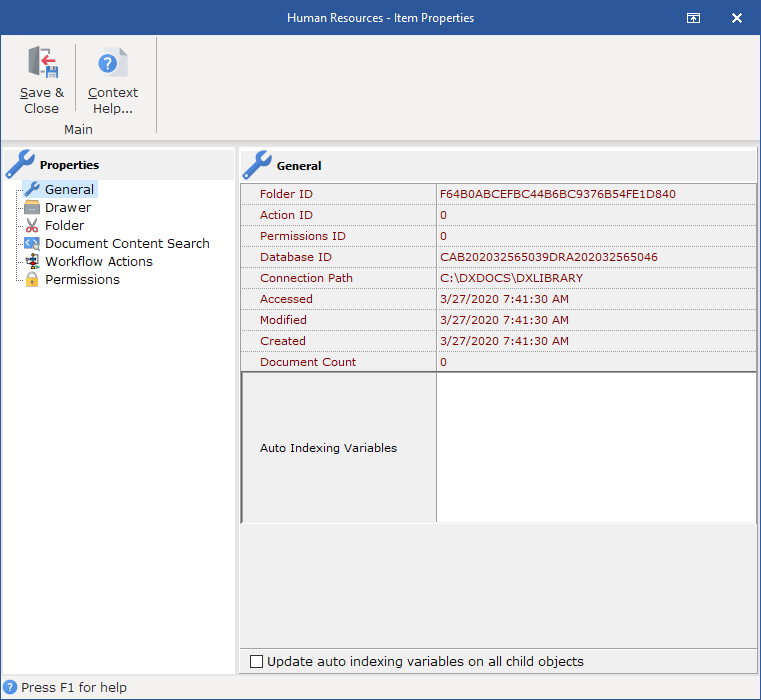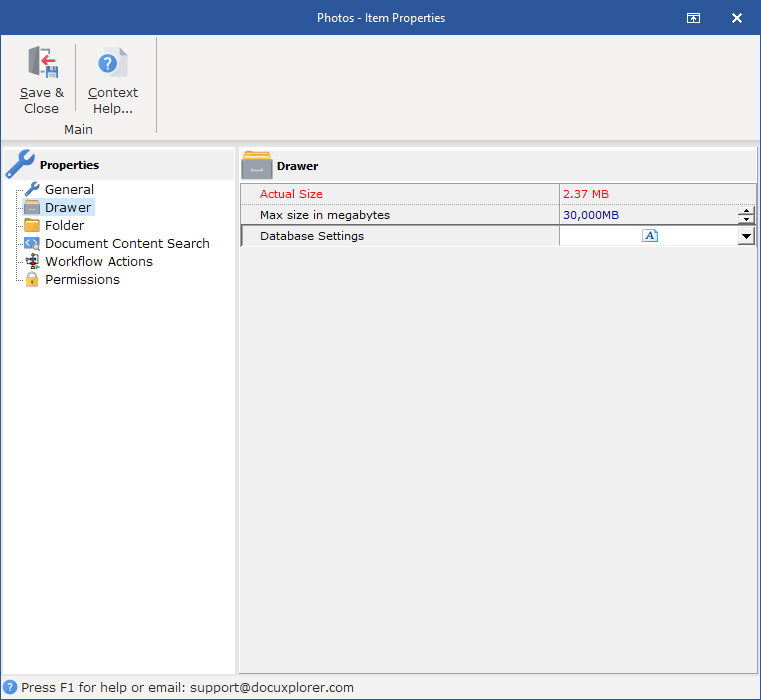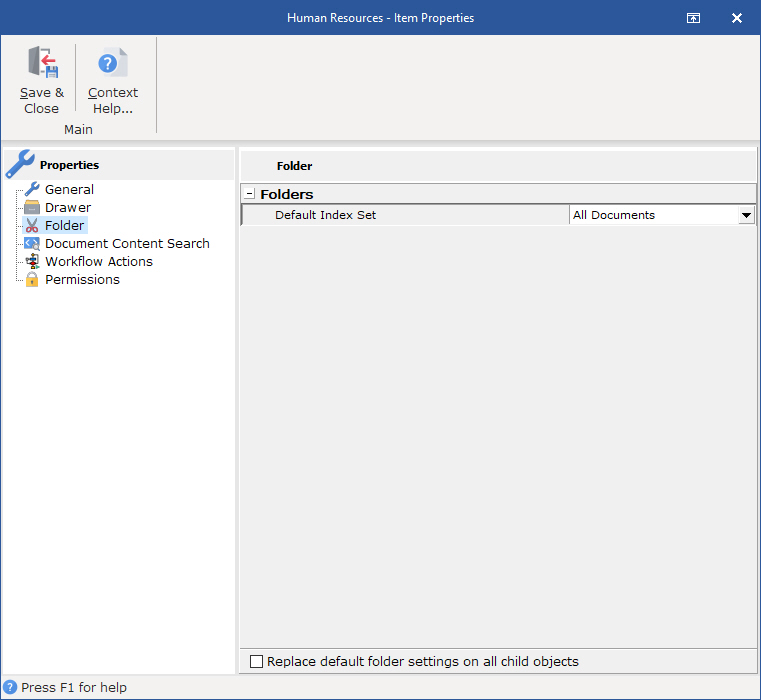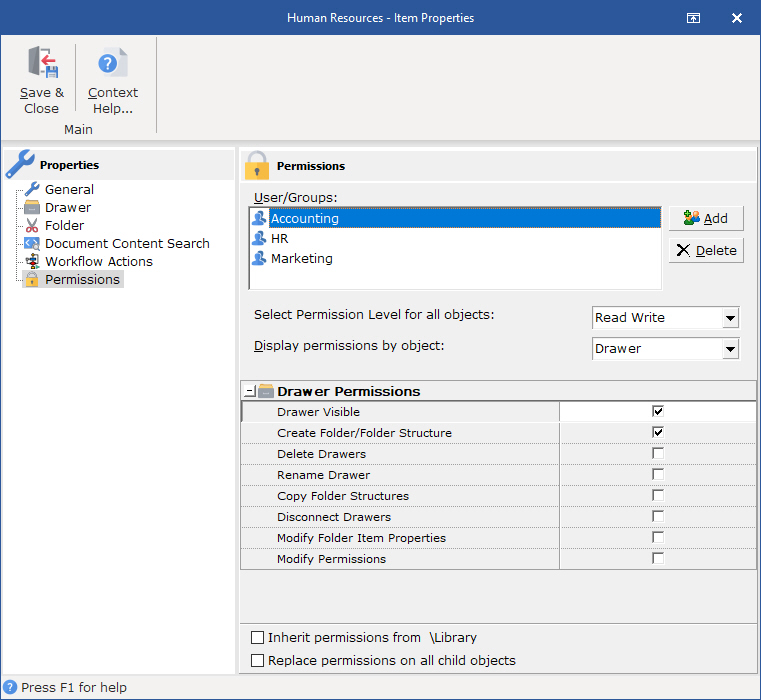
This Help topic refers to the following editions:
þ Enterprise þProfessional þ Personal þ Small Business
From the DocuXplorer Desktop:
To view or change Drawer properties:
Highlight the Drawer icon on the Library Tree
Right click and select Properties on the drop-down menu
The Drawer Properties dialog contains items where administrators can edit Drawer properties;
The General Properties fields contain information about the Drawer. Only the Description Field is editable and can be used for memo information about a Drawer.

Folder ID - this item is the unique ID number given to this object. This item cannot be edited and is used by tech support to determine object identification
Permission ID - this item is the permission set ID either set in this object or inherited by it from a parent object
Database ID - this item is the unique ID number given to the database storing this object. This item cannot be edited and is used by tech support to determine database and object identification
Connection Path - this item provides information on the location and connection path for this object. This item cannot be edited and is used by tech support to determine database and object identification
Accessed - the date and time this object was last accessed
Modified - the date and time this object was modified
Created - the date and time this object was created
Document Count - the number of documents contained in this Drawer
Description - an editable field that can be used to provide a description of what is contained in this Drawer or any other memo information you might want to attach to this Drawer
The Drawer Properties dialog box allows you to monitor database size for the Drawer.

Allows users to set the maximum aggregate size of the Drawer database tables. The aggregate size would include all files that are part of the Drawer - the Drawer tables that contain the index information attached to a document, pointers to documents in the Drawer database tables,and Index Set tables.
Setting a maximum aggregate size provides an alarm dialog to warn when the maximum object size has been reached
Actual size - the actual size of the database table
Max size in GB - The maximum size for a drawer is inherited from the Library object. A user can change the maximum size of a Drawer by changing the size in this field. You can not select a size smaller than the physical size of the drawer. The image above shows a Drawer of 4000 MB or 4 GB. Once the Max size is adjusted Docuxplorer will recalculate the Block Size and number of Blocks allowed for a value close to the requested size. The calculated size will be displayed during the execution process. Click here to see more information about operating system limitations.
should only be used when instructed by an DX engineer. This information is used to adjust performance information for indexes, block size, page size and database format version information.
version=#.##
ximagepagesize=512,1024,2048,4096, 8192
xindexpagesize=
Folder Properties

The Folder Properties dialog box allows you to set the default Index Set for any new Folder created in the Drawer
Replace default folder settings on all child objects - checking this box will change the default Index Set on all child objects.
A Drawer's Document Content Search Properties is inherited from the settings created in <Tools><Options> menu item. Document Content Search options can be changed for each Drawer as a property of the object. Enabling Document Content full text search indexes the contents of documents stored in a Drawer.
Tip:
If a document is in a binary format such as a media file or graphic file, the file information is ignored by the indexing engine. Files like Word, Excel, or WordPerfect store their content information as uncompressed text and allow DocuXplorer to index their content information

Default settings are as follows;
Document Content Search Properties
Enable Search Option - This item must be checked if you want DocuXplorer to index the full text content of electronic documents. If this option is checked a full Index of a document's content is created when the users selects Save & Close. A user will be prompted to confirm this change due to the processing time needed to index the full text of the documents already in the folder. Conversely if the option was initially checked and the user unchecks it, the Document Content Index will be removed when the user selects Save & Close. If Enable Search Options is not checked all other properties in this dialog box will grayed out and unavailable.
Text Options
Conditional Drop Characters - Conditional drop characters are a special type of drop character. These characters are dropped only if they are at the beginning or the end of a word. This provides a mechanism for allowing certain characters to be maintained if they appear inside words. The default conditional drop characters are (,.?!;:@#$%^&()-_).
For example:
One of the default conditional characters is the period. This means that periods on the ends of words will be stripped from the text, but if they are in the middle of a word (e.g., in a number such as 48.5), then they will be maintained.
Drop Characters - Drop characters are a set of characters that are simply ignored by the FTS engine. Drop characters are ignored in both the text and in search strings. The default drop characters are the double quote, the single quote, and the back quote. Administrators can add additional Drop Characters in the Drop Characters/Additional field.
For example:
If the defaults are used and a name such as O'Malley is in the text, the FTS engine will store OMalley (without the quote) as the key value. A search word of either OMalley or O'Malley will find it because the quote would be stripped out of the search word too.
Noise Words - The noise words are words that are ignored by the FTS engine. Once a word is recognized according to the other rules (after obeying delimiters, drop characters, minimum word length, etc.), the word is checked against the noise word list and is ignored if it is found in that list.
The default noise word list includes the following words:
about after all also and another any are because been before being between both but came can come could did does each else for from get got had has have her here him himself his how into its just like make many might more most much must never now only other our out over said same see should since some still such take than that the their them then there these they this those through too under use very want was way well were what when where which while who will with would you your
Delimiters - Delimiters are the set of characters that define word boundaries. The default set of delimiters includes the white space characters, which are the space (0x20), backspace (0x08), tab (0x09), newline (0x0A), vertical tab (0x0B), form feed (0x0C), and carriage return (0x0D). This works for most standard text documents. WordPerfect documents are an example of documents that use delimiters to define boundaries. DocuXplorer has been programmed with the Symbol (highbit) character € that WordPerfect uses to define its boundaries.
Delimiters are always case sensitive. If, for example, you want to use "x" (0x78) and "X" (0x58) as delimiters, then you must specify both characters as delimiters regardless of the case sensitivity option.
Index Options
Minimum Word Length - This option specifies a minimum cut-off point for word recognition. Any word that is shorter than the specified minimum length is simply ignored; these words will not be in the FTS index nor will they be used if they are given in a search condition. When creating an FTS index via SQL, the default minimum word length is 3.
Maximum Word Length - The maximum word length specifies the maximum word size that can be stored in the FTS index. This is effectively the key length of the index. In general, you should try to choose a length that is longer than most or all words that are in the information being indexed. The default maximum word length is 30.
Protect Numbers - This option covers a very specific situation. If it is given and the comma and/or period is given as a delimiter character, then numbers that contain commas and/or periods will not be broken into multiple words on those delimiters. With "normal" text, the default delimiters and conditional drop characters will suffice. Using all default settings, the comma and period are not delimiter characters (they are conditional drop characters). Text such as "1,423.99" would be treated as a single word. If you created an FTS index with the period and comma as delimiter characters, then that text would be broken up into three words "1, 423, and 99". If you use the Protect Numbers option, then this would not occur. This option may be useful, for example, if the text contains words that have only commas between them (with no other delimiters). In that case, it may be desirable to treat the comma as a delimiter.
Maintain Automatically - This option maintains the Full Text indexing information for OCR text and is always enabled and can not be changed
Note: If when setting this option you receive an error that more than user is accessing this Cabinet and you know that you are the only user in Cabinet, simply close the Cabinet and reopen, then place a check in the Maintain Automatically field and the process should continue with error.
Tip:
In the <Tools/Options/Full Text Search dialog> the Maintain Automatically default is set to "Off". The Drawer object of any new Cabinet is then automatically set to "Off" to facilitate the speed of adding documents to Drawers where content indexing of electronic documents is not required. The administrator will need to set a Drawer's Document Content Search Property to "On" to allow document content to be indexed.
Permissions – security not available in DocuXplorer Personal or Small Business

Permissions allow you to add users and groups and set security properties for users and groups in the Drawer.
See the Security/Users/Groups help item for more information on how to add users and groups to a Drawer.
See Security/Drawer Permissions for more information about setting Drawer permissions.
Tip:
Permissions are generally inherited from the Library. To change permissions for the Drawer object you must uncheck the Inherit permissions from parent box before setting new permissions for users or groups.